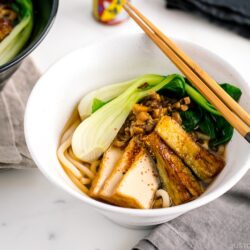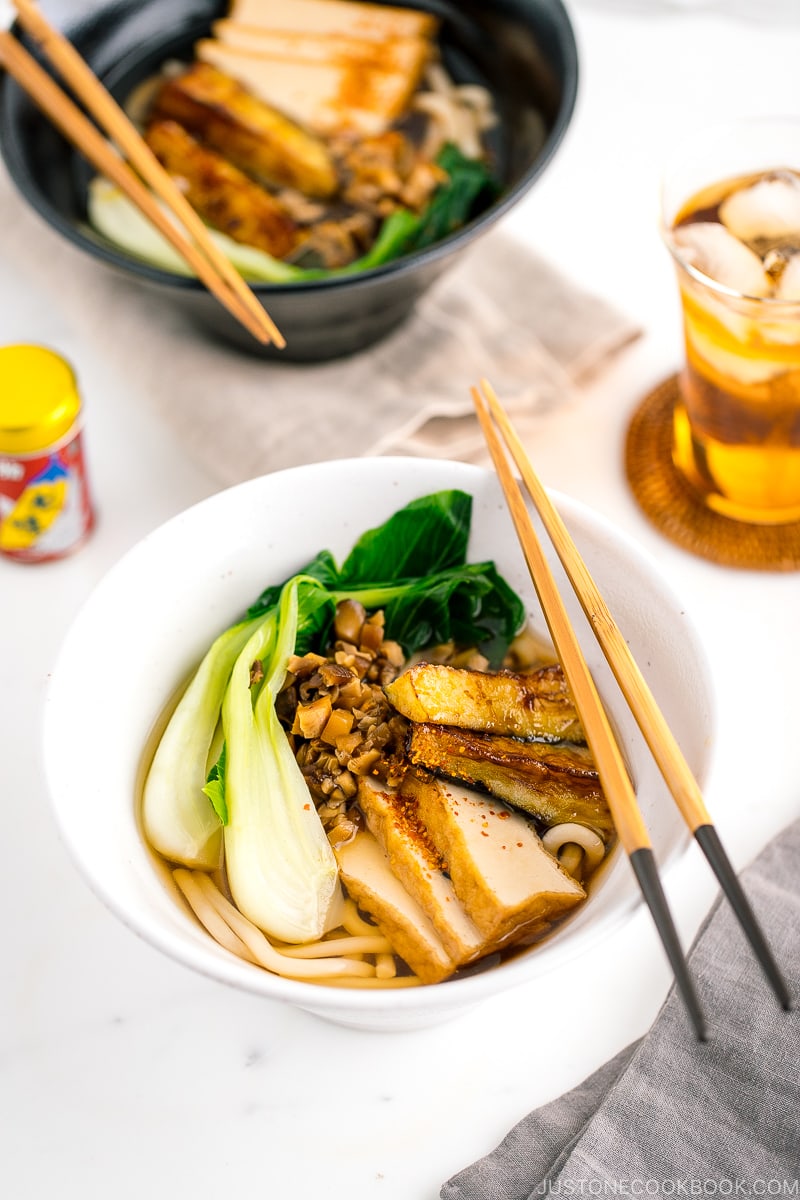
One of my recent challenges has been creating more vegetarian and vegan recipes that are family-approved. They’re a tough crowd when it comes to judging my cooking, but this Vegetarian Udon absolutely won their hearts. It’s light and delicate, yet so flavorful and comforting—we never get tired of it.
The best part? You can easily customize it with whatever you have on hand. Let me show you how I’ve been making this noodle soup!
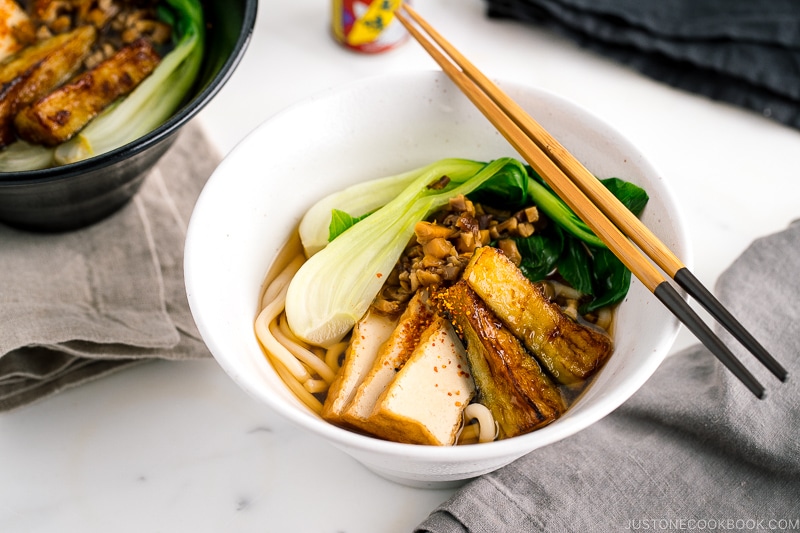
Why You’ll Love This Vegetarian Udon Noodle Soup
- The best dashi broth that is vegan and vegetarian friendly.
- Light yet incredibly flavorful — It’s the power of umami-rich ingredients!
- 3 easy cooking steps — Make the soup broth, prepare the toppings, and heat the udon noodles right before assembling.
- Versatile — Add any toppings you like to keep the dish interesting!
- Make-ahead — You can prepare the soup broth in advance and use it within 3-4 days.
- My non-vegan family approved — By that, it means the udon soup is so flavorful and satisfying that they didn’t miss the meat or fish in the broth or toppings.
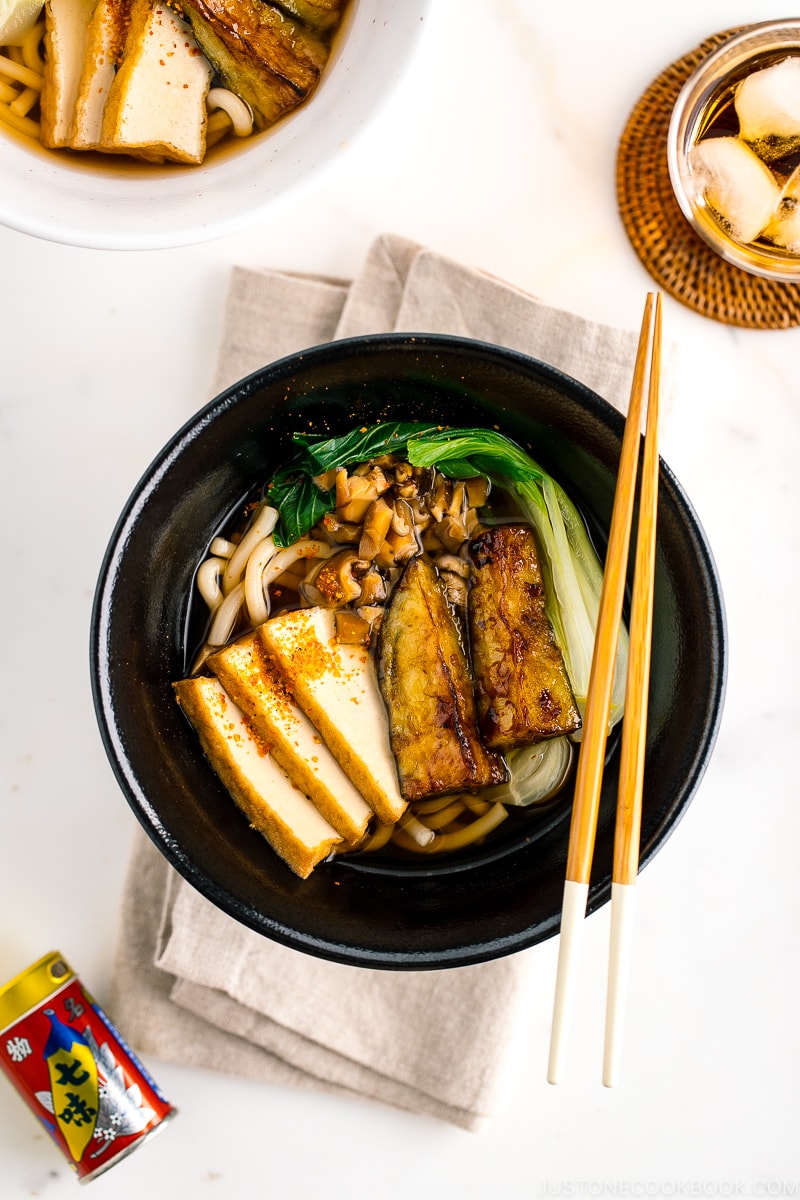
3 Key Ingredients for a Delicious Vegetarian Udon!
1. Vegan Dashi (Japanese Soup Stock)
I hope all my vegan and vegetarian readers try making udon noodle soup with dashi instead of vegetable broth. Many people don’t realize that dashi can be vegan or vegetarian, as it’s sometimes translated as “seafood stock.”
As I mentioned in my ultimate dashi guide post, you can create authentic Japanese flavor by using dashi made with just kombu and dried shiitake mushrooms. The right soup stock will give your Japanese cooking a subtle yet rich umami character.
2. Sweet and Savory Minced Mushrooms
First, I rehydrated the dried shiitake mushrooms to extract their umami and used the liquid for the broth. Instead of tossing the mushrooms away, I minced them and used them as a topping for the udon soup.
They’re practical and economical, so no mushrooms go to waste! If you prefer to use the mushrooms for something else, save them for a stir-fry, hot pot, or as an addition to rice.
3. Crispy Tofu & Fried Seasoned Eggplant
When I think of a satisfying ingredient for my omnivore family, I need savory and hearty food for maximum enjoyment.
I love using both fried tofu and eggplant in this dish because frying enhances the overall flavor. Some of you might want to keep it “healthier” by avoiding oil, and that’s okay. But if you’re all for delicious bites, definitely try this. Think about it this way: Between fried tofu and regular tofu, which one is more flavorful?
I used ready-fried tofu in this recipe and only needed to fry the eggplant. Eggplant acts like a sponge, absorbing all the flavors from the seasoning! Make sure to coat the eggplant with potato starch (or cornstarch) for extra crispiness. This step is really important!
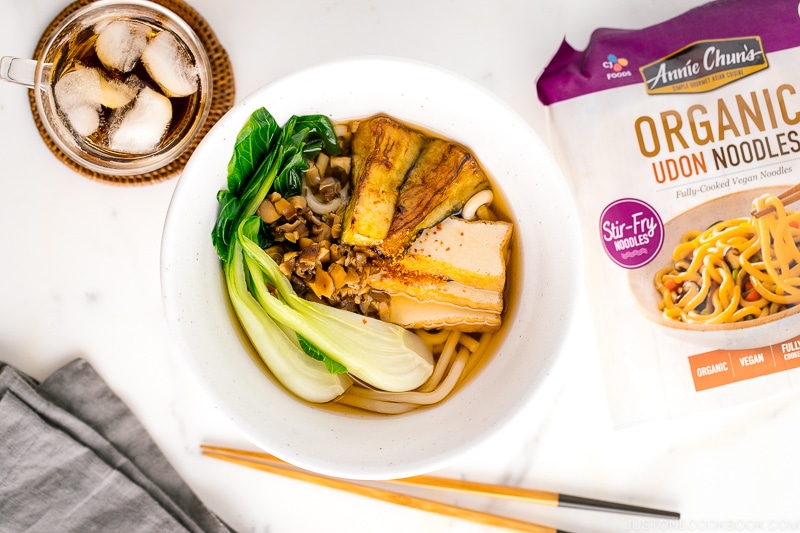
What Types of Udon Noodles
I recently discovered Annie Chun’s Organic Udon Noodles and was impressed by the quality and convenience of the product. I had been using frozen or refrigerated udon noodles, but I didn’t realize that there are udon noodles like these that are fully cooked and sealed for freshness. You can easily store them in a cool, dark place or kitchen pantry and use them whenever you need them! How cool is that?
Annie Chun’s Organic Udon Noodles are:
- Organic and high in quality.
- Able to be stored in the pantry (yes, at room temperature).
- Pre-cooked, so you can put together a tasty meal in a flash!
It’s great for emergencies, and you can keep your refrigerator or freezer space open for other foods.
If you can find frozen Sanuki Udon in Asian markets, then it would be the best.
Prefer fresh udon noodles? Try making my Homemade Udon Noodles!
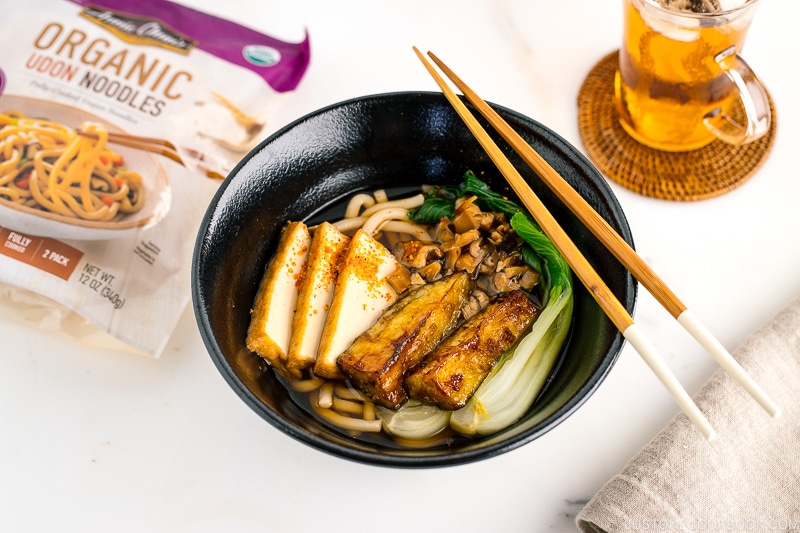
10 Helpful Cooking Tips
- If you have time, soak kombu and dried shiitake mushrooms in water overnight in the fridge for slow steeping; otherwise, just 30 minutes will do.
- Cut the eggplants into wedges with the skin-on, so they will keep their shape after cooking.
- Use potato starch (or cornstarch) to make the eggplant crispy. Don’t skip this step.
- Don’t skimp on the oil when cooking the eggplants. The oil helps crisp up the texture.
- Cut mushrooms into small bits that mimic the texture of meat.
- Keep adding water when simmering the minced mushrooms with seasonings. This will intensify the flavors as it cooks, and you won’t have to worry too much about overcooking.
- Remove the kombu from the dashi broth right before boiling to avoid sliminess and bitterness. You can reuse this kombu to make furikake rice seasoning or simmered kombu tsukudani.
- Heat up fried tofu in the broth if you like, but it’s not necessary.
- Blanch the leafy green vegetables in the same pot of boiling water that you use to cook the udon noodles.
- You can add udon noodles directly to the soup broth if you’re using Annie Chun’s organic noodles (as per the package instructions). However, I prefer to keep my broth clean and clear (without starch from the noodles), so I quickly loosen them in a separate pot of boiling water (used for blanching vegetables).
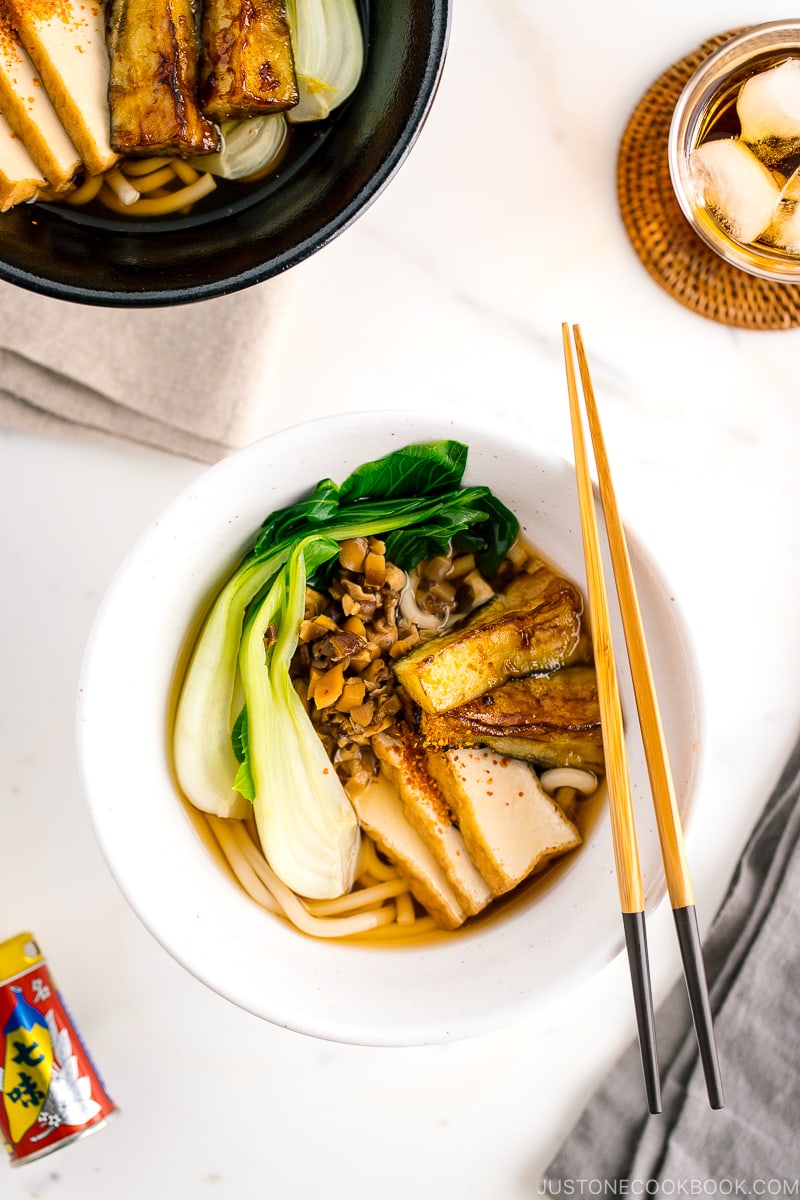
Substitutions
- Kombu and Dried Shiitake Mushrooms: These are key ingredients for the broth. You can use just one of them, but I strongly recommend using both, as each provides distinct umami flavors. If you have no access to either ingredient, vegetable broth is your last resort, though it will unfortunately lack authentic Japanese flavors.
- Fresh Shiitake Mushrooms: I use these to add more volume to the minced dried shiitake mushrooms. You can substitute any mushrooms, such as portobello or king oyster.
- Eggplant: You can substitute with zucchini, potatoes, sweet potatoes, or roasted squash.
- Fried Tofu: You can use crispy baked tofu or regular tofu (but avoid silken tofu, as it breaks easily).
- Bok Choy: Any green veggies can add freshness. I prefer leafy greens that I can blanch right before cooking the udon noodles.
Have more questions about ingredients? Leave a comment below, and we’ll be happy to help!
More Delicious Udon Recipes You’ll Love
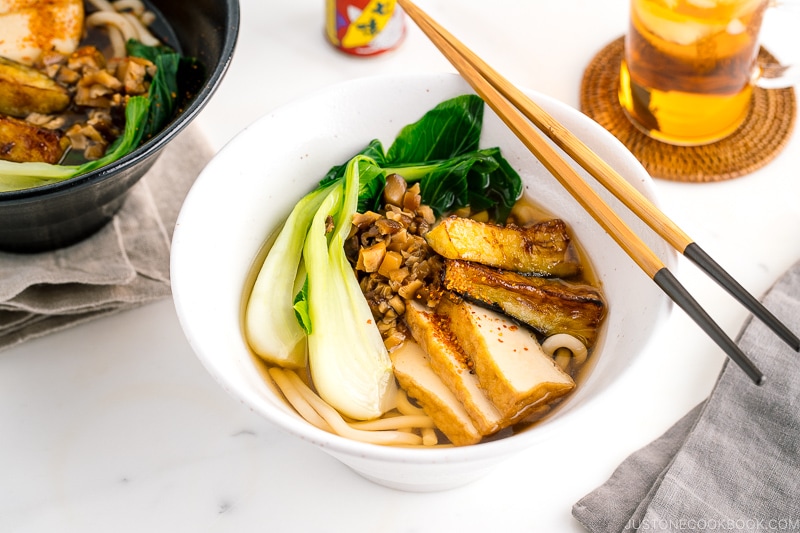
Wish to learn more about Japanese cooking? Sign up for our free newsletter to receive cooking tips & recipe updates! And stay in touch with me on Facebook, Pinterest, YouTube, and Instagram.
Vegetarian Udon
Ingredients
For Udon Soup Broth
- 2½ cups water
- 1 piece kombu (4 g; roughly 3 x 3 inches or 7.5 x 7.5 cm per piece)
- 2 pieces dried shiitake mushrooms (17 g, 0.6 oz for the dashi broth and the minced mushrooms below)
- 1 Tbsp soy sauce
- 1 Tbsp mirin
- 1 tsp sugar
- ¼ tsp Diamond Crystal kosher salt
- 12 oz udon noodles (2 packages of AnnieChun's organic udon noodles)
For the Crispy Seasoned Eggplant
- 1 Japanese or Chinese eggplant (126 g, 4.4 oz)
- 1 Tbsp potato starch or cornstarch
- 3 Tbsp oil
- 1 Tbsp mirin
- 1 Tbsp soy sauce
For the Sweet and Savory Minced Mushrooms
- 2 shiitake mushrooms (fresh; substitute portobello, king oyster, etc.)
- 1 Tbsp soy sauce
- ½ Tbsp sugar
- 2 Tbsp water (you can add more to cook for a longer time)
For the Toppings
- 2 Shanghai bok choy
- 3 oz deep-fried firm tofu cutlet (atsuage) (½ package)
- shichimi togarashi (Japanese seven spice) (optional; for kicking up the flavor)
Instructions
- Before You Start…Please note that this recipe requires at least 30 minutes of soaking time. Gather all the ingredients.
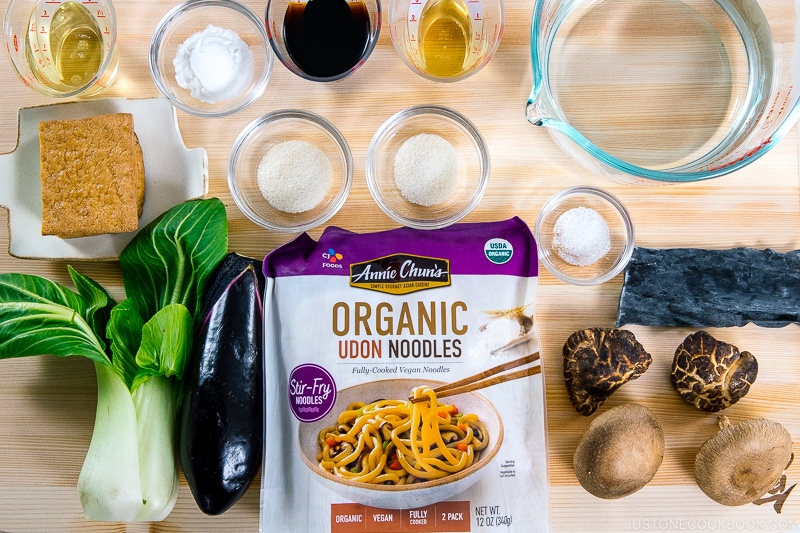
To Make Vegan Dashi Broth
- In a medium pot or bowl, add 2½ cups water, 1 piece kombu, and 2 pieces dried shiitake mushrooms. Steep for at least 30 minutes or overnight.
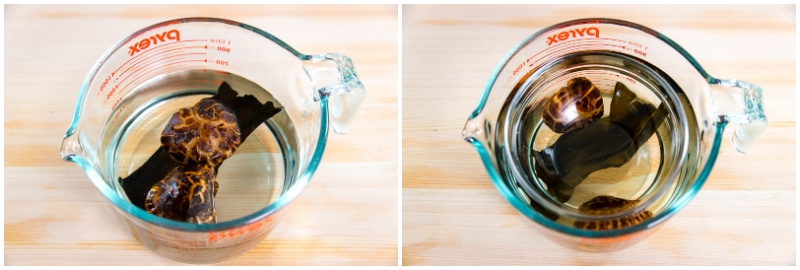
To Make the Crispy Seasoned Eggplant
- Trim off the ends of 1 Japanese or Chinese eggplant and cut into roughly 2-inch wedges with the skin-on. The skin will hold the shape together. Without the skin, the flesh will become too soft.
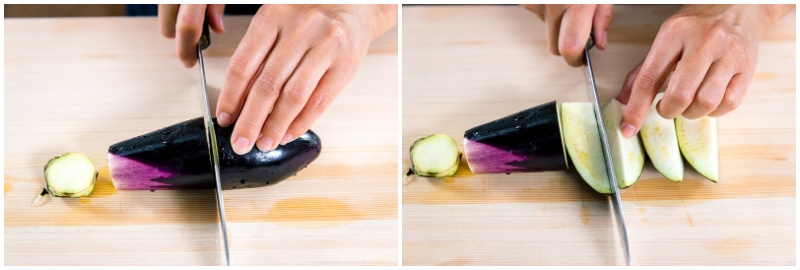
- As soon as you cut the eggplant, soak them in water to remove astringency. Set aside for 10–15 minutes and dry them with a paper towel.
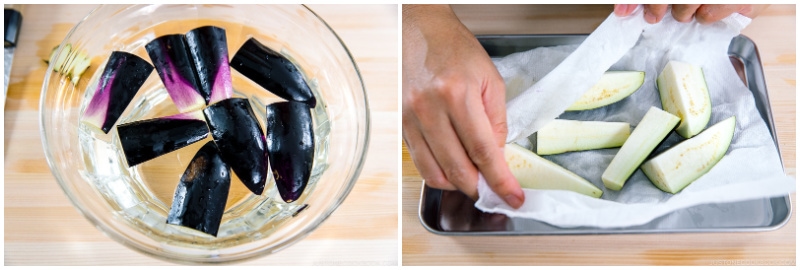
- Sprinkle 1 Tbsp potato starch or cornstarch and coat the eggplant nicely.
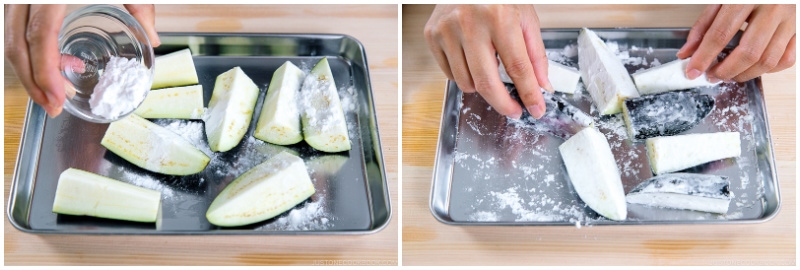
- Heat the oil in a large frying pan over medium-high heat (or medium heat on a professional stove). Start frying the eggplant. Do not touch too often. Only flip them when the bottom sides are nicely brown. If they stick to the pan, be patient and wait till the eggplant slice release itself from the bottom when they form a nice crust (but be sure that pan is greased).
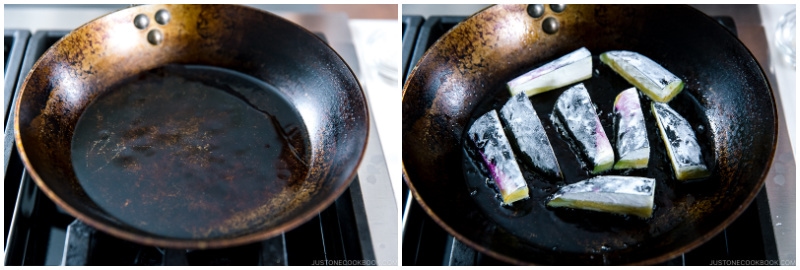
- If you feel that 3 Tbsp oil is not enough, then add more. Make sure to adjust the heat so it doesn’t take a long time to brown the eggplant. You don’t want overcooked and mushy eggplant.
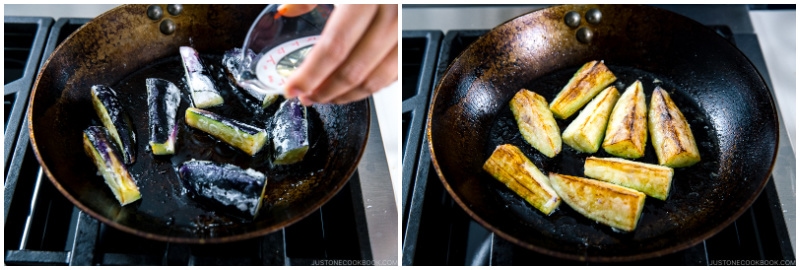
- When the eggplant is golden brown, reduce the heat to medium and season the eggplant with 1 Tbsp mirin and 1 Tbsp soy sauce.

- The potato starch (or cornstarch) will thicken the sauce quickly, so flip around to coat the eggplant with the sauce. Then transfer to a plate.
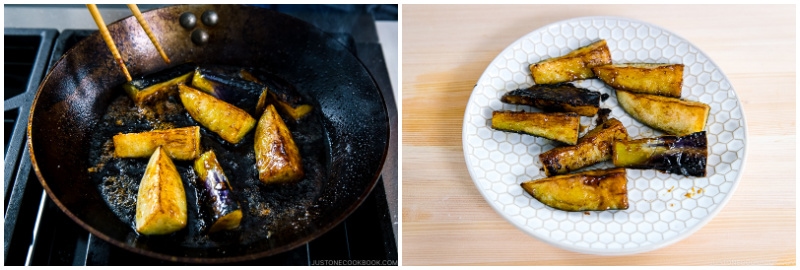
To Prepare the Other Toppings
- Cut the 3 oz deep-fried firm tofu cutlet (atsuage) into thin slices.
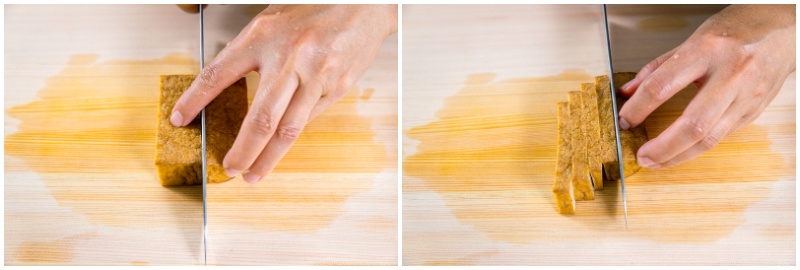
- Cut 2 Shanghai bok choy in half lengthwise.

To Make the Sweet and Savory Minced Mushrooms
- Remove the stems of 2 shiitake mushrooms and slice the caps thinly.
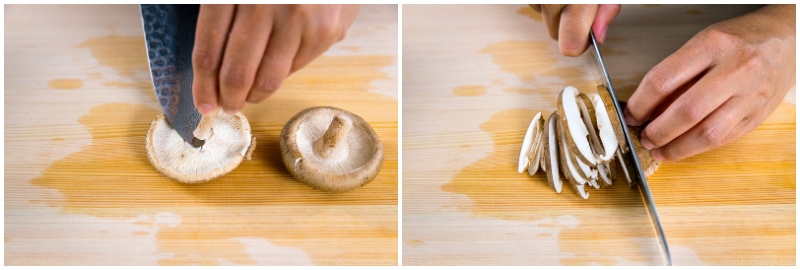
- Then mince the slices.
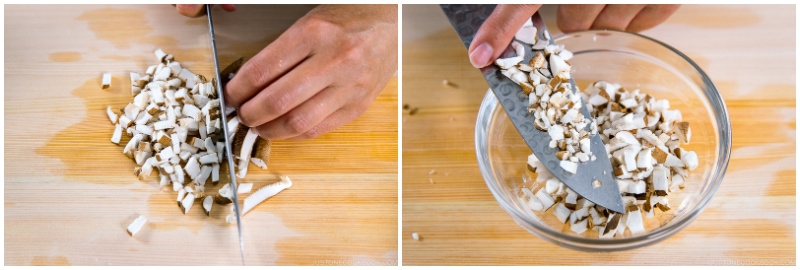
- Squeeze the liquid out from the dried shiitake mushrooms (keep that liquid for the soup broth) and remove the stems.
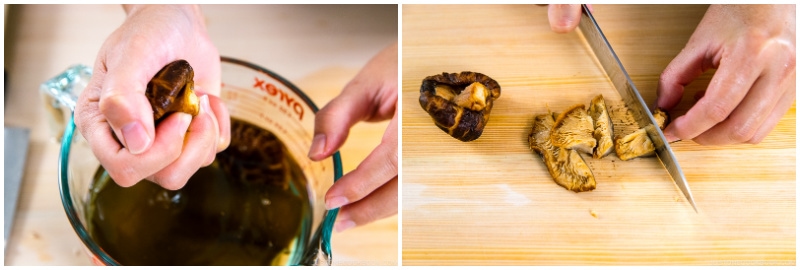
- Cut the mushroom caps into thin slices and then mince them.
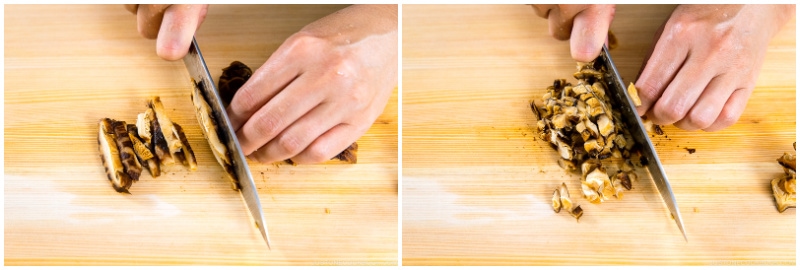
- Cut the dried shiitake mushrooms into the same size as fresh shiitake mushrooms.
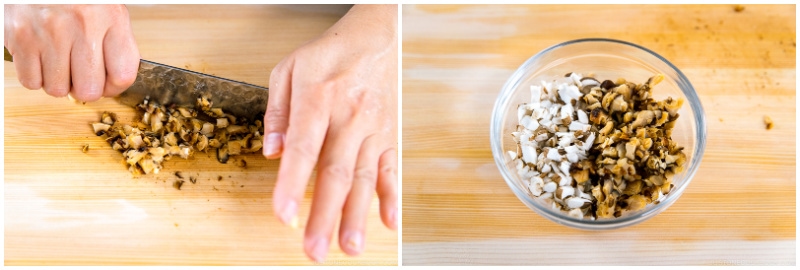
- In a small saucepan, add both mushrooms, ½ Tbsp sugar, and 1 Tbsp soy sauce.
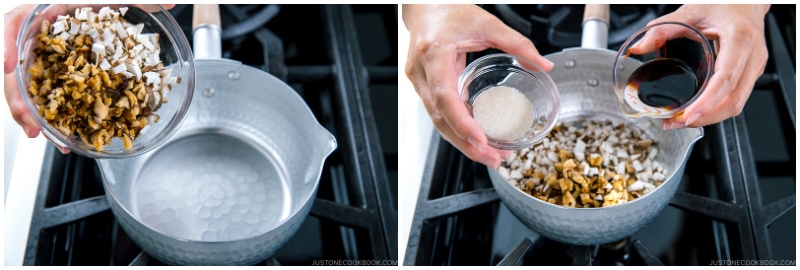
- Add 2 Tbsp water and bring it to a simmer. Continue adding water so the bottom of the pot has some liquid.
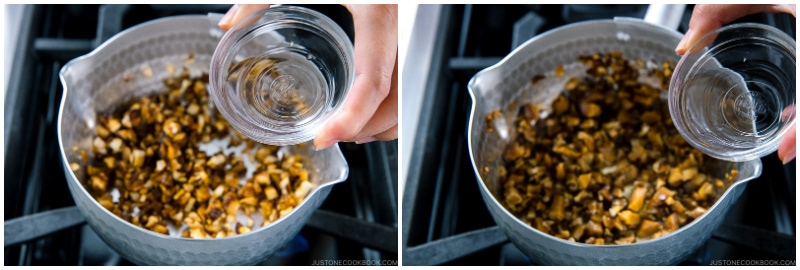
- Simmer until the shiitake mushrooms are tender and absorb the flavors.
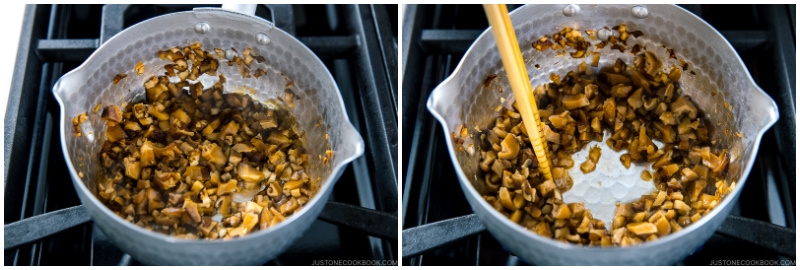
To Make the Udon Soup Broth
- Transfer the kombu and shiitake dashi broth (including the hydrated kombu) to the saucepan and bring it to a simmer.
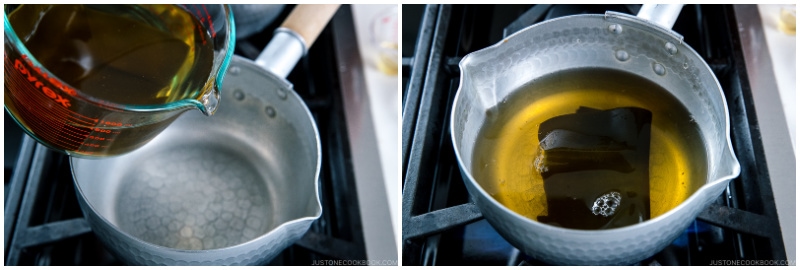
- Right before boiling, remove the kombu. With a fine-mesh simmer, skim off the foam and scum floating on the surface of the broth.
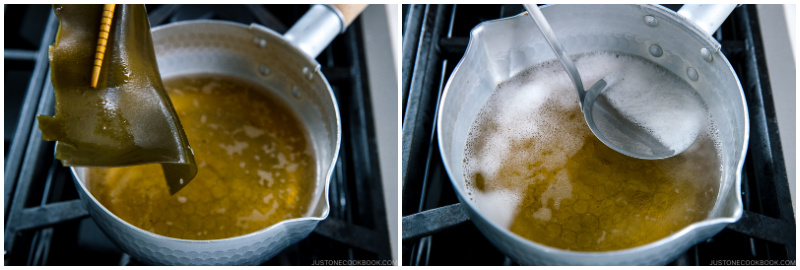
- Add 1 Tbsp mirin, 1 tsp sugar, and 1 Tbsp soy sauce.
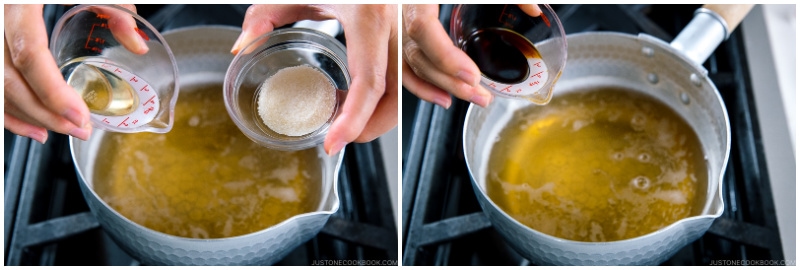
- Add ¼ tsp Diamond Crystal kosher salt and the fried tofu. Taste the soup and adjust the seasonings if needed. Turn off the heat and cover (so it won’t evaporate).
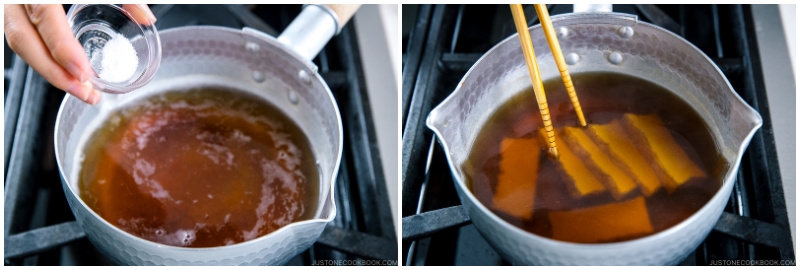
To Blanch the Bok Choy, Cook the Noodles, and Assemble
- In a large pot of boiling water, blanch the bok choy just until it turns bright green and tender, about 2 to 2½ minutes, and transfer to a plate. I undercook slightly and so the remaining heat will continue to cook a bit more. For this recipe, I didn‘t “blanch and shock“ for retaining the vegetable color and crunch as I usually do since I wanted to keep the bok choy warm.
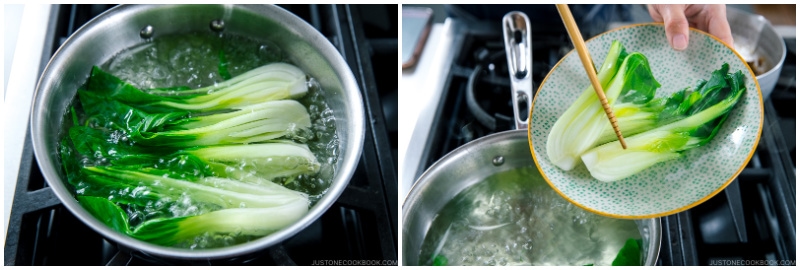
- Cook or reheat 12 oz udon noodles according to the package instructions.
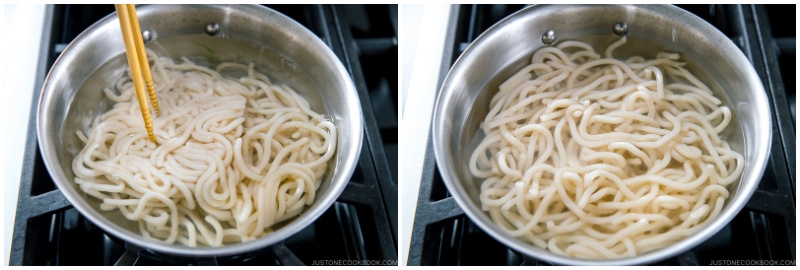
- Drain the udon noodles well and serve them in individual bowls. Divide and serve the fried firm tofu and soup broth.
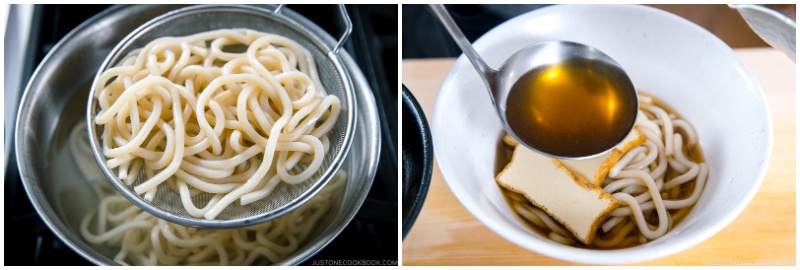
- Top the noodles with blanched bok choy, minced mushrooms, and fried eggplant. Serve immediately with shichimi togarashi (Japanese seven spice) on the side for a spicy kick.
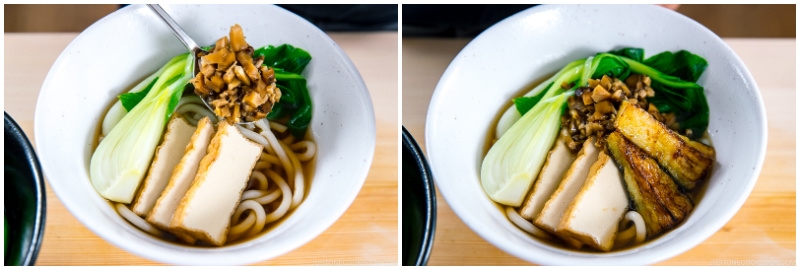
Nutrition
Did you make this recipe?
Tag @justonecookbook on Instagram so we can see your delicious creation!


